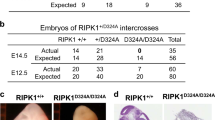Abstract
A previous study showed that the EphA7 receptor regulates apoptotic cell death during early brain development. In this study, we provide evidence that the EphA7 receptor interacts with death receptors such as tumor necrosis factor receptor 1 (TNFR1) to decrease cell viability. We showed that ephrinA5 stimulates EphA7 to activate the TNFR1-mediated apoptotic signaling pathway. In addition, a pull-down assay using biotinylated ephrinA5-Fc revealed that ephrinA5-EphA7 complexes recruit TNFR1 to form a multi-protein complex. Immunocytochemical staining analysis showed that EphA7 was co-localized with TNFR1 on the cell surface when cells were incubated with ephrinA5 at low temperatures. Finally, both the internalization motif and death domain of TNFR1 was important for interacting with an intracytoplasmic region of EphA7; this interaction was essential for inducing the apoptotic signaling cascade. This result suggests that a distinct multi-protein complex comprising ephrinA5, EphA7, and TNFR1 may constitute a platform for inducing caspase-dependent apoptotic cell death.
Similar content being viewed by others
References
Brantley-Sieders, D.M., Zhuang, G., Hicks, D., Fang, W.B., Hwang, Y., Cates, J.M., Coffman, K., Jackson, D., Bruckheimer, E., Muraoka-Cook, R.S., et al. (2008). The receptor tyrosine kinase EphA2 promotes mammary adenocarcinoma tumorigenesis and metastatic progression in mice by amplifying ErbB2 signaling. J. Clin. Invest. 118, 64–78.
Ciossek, T., Millauer, B., and Ullrich, A. (1995). Identification of alternatively spliced mRNAs encoding variants of MDK1, a novel receptor tyrosine kinase expressed in the murine nervous system. Oncogene 10, 97–108.
de la Rosa, E.J., and de Pablo, F. (2000). Cell death in early neural development: beyond the neurotrophic theory. Trends Neurosci. 23, 454–458.
Depaepe, V., Suarez-Gonzalez, N., Dufour, A., Passante, L., Gorski, J.A., Jones, K.R., Ledent, C., and Vanderhaeghen, P. (2005). Ephrin signalling controls brain size by regulating apoptosis of neural progenitors. Nature 435, 1244–1250.
Gu, C., Shim, S., Shin, J., Kim, J., Park, J., Han, K., and Park, S. (2005). The EphA8 receptor induces sustained MAP kinase activation to promote neurite outgrowth in neuronal cells. Oncogene 24, 4243–4256.
Hsu, H., Huang, J., Shu, H.B., Baichwal, V., and Goeddel, D.V. (1996a). TNF-dependent recruitment of the protein kinase RIP to the TNF receptor-1 signaling complex. Immunity 4, 387–396.
Hsu, H., Shu, H.B., Pan, M.G., and Goeddel, D.V. (1996b). TRADD-TRAF2 and TRADD-FADD interactions define two distinct TNF receptor 1 signal transduction pathways. Cell 84, 299–308.
Kuan, C.Y., Roth, K.A., Flavell, R.A., and Rakic, P. (2000). Mechanisms of programmed cell death in the developing brain. Trends Neurosci. 23, 291–297.
Lee, S.Y., Reichlin, A., Santana, A., Sokol, K.A., Nussenzweig, M.C., and Choi, Y. (1997). TRAF2 is essential for JNK but not NFkappaB activation and regulates lymphocyte proliferation and survival. Immunity 7, 703–713.
Lim, Y.S., McLaughlin, T., Sung, T.C., Santiago, A., Lee, K.F., and O’Leary, D.D. (2008). p75(NTR) mediates ephrin-A reverse signaling required for axon repulsion and mapping. Neuron 59, 746–758.
Locksley, R.M., Killeen, N., and Lenardo, M.J. (2001). The TNF and TNF receptor superfamilies: integrating mammalian biology. Cell 104, 487–501.
Marler, K.J., Becker-Barroso, E., Martinez, A., Llovera, M., Wentzel, C., Poopalasundaram, S., Hindges, R., Soriano, E., Comella, J., and Drescher, U. (2008). A TrkB/EphrinA interaction controls retinal axon branching and synaptogenesis. J. Neurosci. 28, 12700–12712.
Noh, H., and Park, S. (2010). Ectopic expression of Ephrin-A5 under the EphA8 promoter at the anterior region of the superior colliculus. Exp. Neurobiol. 19, 49–53.
Park, E., Kim, Y., Noh, H., Lee, H., Yoo, S., and Park, S. (2013). EphA/ephrin-A signaling is critically involved in region-specific apoptosis during early brain development. Cell Death Differ. 20, 169–180.
Schneider-Brachert, W., Tchikov, V., Neumeyer, J., Jakob, M., Winoto-Morbach, S., Held-Feindt, J., Heinrich, M., Merkel, O., Ehrenschwender, M., Adam, D., et al. (2004). Compartmentalization of TNF receptor 1 signaling: internalized TNF receptosomes as death signaling vesicles. Immunity 21, 415–428.
Schutze, S., and Schneider-Brachert, W. (2009). Impact of TNF-R1 and CD95 internalization on apoptotic and antiapoptotic signaling. Results Probl. Cell Differ. 49, 63–85.
Schutze, S., Tchikov, V., and Schneider-Brachert, W. (2008). Regulation of TNFR1 and CD95 signalling by receptor compartmentalization. Nat. Rev. Mol. Cell Biol. 9, 655–662.
Shin, J., Gu, C., Park, E., and Park, S. (2007). Identification of phospho-tyrosine binding domain-containing proteins as novel downstream targets of the EphA8 signaling function. Mol. Cell. Biol. 27, 8113–8126.
Wajant, H., Pfizenmaier, K., and Scheurich, P. (2003). Tumor necrosis factor signaling. Cell Death Differ. 10, 45–65.
Yeo, W., and Gautier, J. (2004). Early neural cell death: dying to become neurons. Dev. Biol. 274, 233–244.
Yoo, S., Kim, Y., Lee, H., and Park, S. (2012). A gene trap knockout of the Tiam-1 protein results in malformation of the early embryonic brain. Mol. Cells 34, 103–108.
Author information
Authors and Affiliations
Corresponding author
About this article
Cite this article
Lee, H., Park, E., Kim, Y. et al. EphrinA5-EphA7 complex induces apoptotic cell death via TNFR1. Mol Cells 35, 450–455 (2013). https://doi.org/10.1007/s10059-013-0072-3
Received:
Revised:
Accepted:
Published:
Issue Date:
DOI: https://doi.org/10.1007/s10059-013-0072-3




